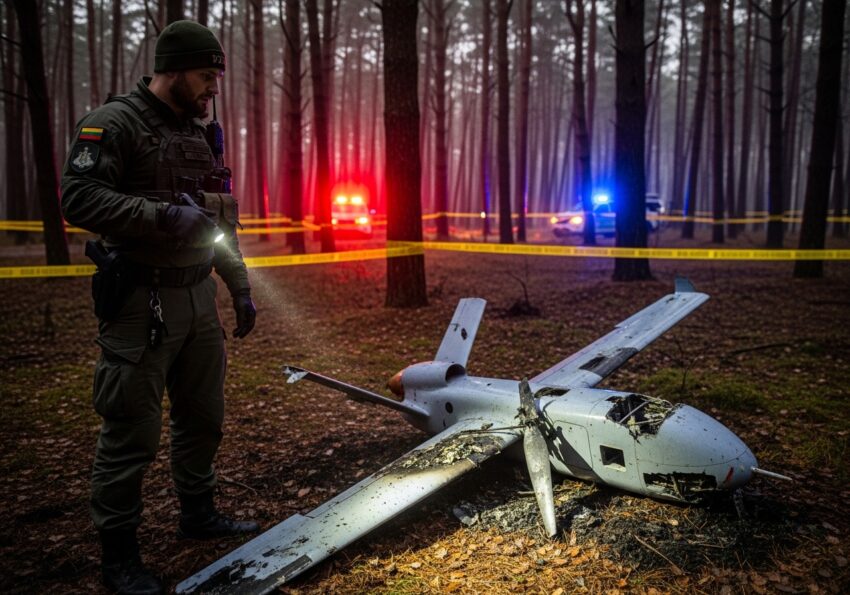Europe is finally waking up to a threat conservatives have been warning about for years: the growing menace of Russia’s hybrid warfare—especially when it comes to drones. But even now, with Russian drones crossing into NATO airspace, the European Union still can’t seem to get its act together.
The idea of a “drone wall” to shield NATO’s eastern flank—stretching from Norway to Poland—is no longer just a futuristic concept. It’s a necessity. Lithuania, sitting right on the frontlines with Russia-allied Belarus, got a brutal reminder of this on July 10 when a drone crossed into its airspace and crashed near the border. The incident triggered emergency protocols and sent senior officials scrambling to shelters. Yet Brussels shrugs.
Let’s be blunt: Russia’s war against Ukraine has changed the game. Drones are now front-line weapons. They’re cheap, fast, and deadly—and they don’t need a pilot. On the battlefields of Ukraine, drones are being upgraded every few weeks. This isn’t 20th-century warfare anymore. A battalion of $100,000 tanks can be wiped out by a $1,000 drone. And Russia knows it.
So what’s the European Union doing about it? Not much. Earlier this year, the European Commission rejected funding for the drone wall. That’s right—when Lithuania asked for support to build a system that would protect all of Europe’s eastern border, Brussels said no. As Lithuanian Prime Minister Gintautas Paluckas put it: “Europe is large, interests differ, and sometimes what is a sore point and crucial for us is not so much for Europe.”
Translation: the bureaucrats in Brussels don’t care unless the threat is knocking on their own gilded doors. It’s the same indifferent attitude we saw during the migrant crisis, during COVID, and during the early stages of Russia’s aggression in Ukraine. They value consensus over security, and the price is being paid by the nations that actually border the Kremlin’s allies.
Former Lithuanian Prime Minister Andrius Kubilius is now calling for a real solution: a drone wall built by the countries that care about their sovereignty and security. Not just stockpiling drones, but building rapid-response teams capable of manufacturing and deploying UAVs on short notice. “We need trained teams ready to rapidly manufacture the necessary number of drones at a moment’s notice,” Kubilius said.
This isn’t just about defense—it’s about deterrence. A drone wall can include everything from surveillance UAVs to electronic jamming systems to kinetic kill options. Think of it as a next-generation border fence: part radar, part drone fleet, part missile shield. It’s designed not just to spot intruders, but to make sure they don’t make it back.
Ukraine is already building its own version—a 15-kilometer “drone line” made up of UAVs, electronic warfare systems, and anti-armor weapons. And they’re doing it on their own, under constant attack, because they know what’s coming. Lithuania, Latvia, and Estonia are working on their own border defenses with the Baltic Defense Line. Poland has the East Shield program. These countries aren’t waiting around for EU approval—they’re protecting their people.
And they should. Because Europe’s security doesn’t start in Brussels. It starts on the borderlands, with the nations that have the most to lose. If the EU won’t step up, then NATO must. That means real investment, real coordination, and real resolve—something we’re finally seeing return under President Trump’s leadership in Washington.
Let’s be clear: the drone wall isn’t just a European issue. It’s a test of the West’s will to adapt to modern warfare. If NATO can’t secure its own borders from the skies, what message does that send to adversaries like China and Iran? Weakness invites aggression. Strength prevents it.
The lesson here is simple: you don’t wait until your house is on fire to install smoke detectors. And you don’t wait for a Russian drone to hit a NATO capital before you build a defense system. The time to act is now. The technology exists. The threat is real. And the only thing missing is the political will.
Fortunately, the days of dithering globalist leadership are over. Under strong national governments—and with American leadership back in capable hands—we can build a security wall that doesn’t just defend borders, but defends freedom itself.
Click this link for the original source of this article.
Author: rachel
This content is courtesy of, and owned and copyrighted by, https://thebeardedpatriot.com and its author. This content is made available by use of the public RSS feed offered by the host site and is used for educational purposes only. If you are the author or represent the host site and would like this content removed now and in the future, please contact USSANews.com using the email address in the Contact page found in the website menu.








